Dublin and Dingle
Journal
On the plane I read about Dublin in my Lonely Planet. I found that one part of town with inexpensive accommodation
is in along Gardiner Street (remember that my surname is "Gardiner").
Even better, there is a Gardiner Lodge on Gardiner Street. How
could I stay anywhere else? After the plane landed and I collected my
backpack at the carousel, I caught the bus into town, deposited at a station
two minutes from the aforementioned Gardiner Street. My excitement
was short-lived, for I soon discovered that the
Gardiner Lodge on Gardiner Street was full. As much as I flashed my
passport and California driver's license to convince them that I belonged there, they
sent me further down the street. Most of the other places on the street were full,
though I was determined to stay on my namesake, so I found a hostel that had decent rooms but was otherwise
suspect (read on to find out why).
Now that I had been in Dublin for two hours it was time to find a  good
pint. In college I had talked about making a pilgrimage to St. James'
Gate, but it was too late in the day to attempt. Instead I walked into
the more touristy Temple Bar area, nursed a blonde in a black skirt (that would be a
pint), and listened to some traditional Irish music.
good
pint. In college I had talked about making a pilgrimage to St. James'
Gate, but it was too late in the day to attempt. Instead I walked into
the more touristy Temple Bar area, nursed a blonde in a black skirt (that would be a
pint), and listened to some traditional Irish music.
Dublin is a big, gray, dirty city. Were it not for its literary history
and pub culture it could be any another large city. This insight required one evening to
discover though five more evenings to verify. The Liffey River divides the
city in two. It is not an inviting body of water for a swim. The north
side has cheap accommodations while the
south side boasts Trinity University, St. Stephen's Green, the Guinness factory,
and the best pubs.
Even though it was refreshing to be in a place where everyone speaks English,
I was tired from a long day of travel, so I returned back to my hostel on
Gardiner Street. Around this time I learned the importance of inspecting the
bathrooms before committing to a room, while throughout the night I continually re-discovered our
proximity to the railway. In the morning I discovered the showers--more like
metal cages built for torture than a place to bathe.
I decided that morning to look for
another hostel. My guidebook praised one called "The Ab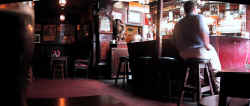 bey." This one passed a more careful
inspection and had a pub-worthy name, yet it was significantly more
expensive at 17 punts compared to 10. Still, it was much more pleasant so
I decided to stay. After dropping off my bags, I headed
into the center
of town. At least I had spent one night on Gardiner Street.
bey." This one passed a more careful
inspection and had a pub-worthy name, yet it was significantly more
expensive at 17 punts compared to 10. Still, it was much more pleasant so
I decided to stay. After dropping off my bags, I headed
into the center
of town. At least I had spent one night on Gardiner Street.
I struck out for The Brazen Head, reputedly Dublin's oldest pub. Joyce
refers to it
in Ulysses, though not exactly lauding it with, "You get a decent enough do at
the Brazen Head," or something to this effect. Pub lunches are the best
cheap meal in Ireland so I happily helped myself to "a decent enough
do" before the Guinness
Pilgrimage. I was too 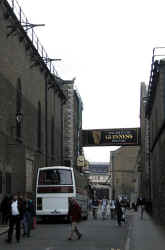 early
for lunch but not too early for a pint, so I sat down with a glass to wait for the lunch
buffet of roasted ham, boiled vegetables, and potatoes.
early
for lunch but not too early for a pint, so I sat down with a glass to wait for the lunch
buffet of roasted ham, boiled vegetables, and potatoes.
After tucking away a massive plate of food it was time to head to the
Guinness Hopstore. The Hopstore is a museum devoted to Guinness. The
name "Hopstore" comes from the
building that houses it; hops used to be stored there. Nowadays this
building could store only a fraction of the hops for daily brewing, so the
company turned it into a visitor center. You can still smell the pungent
odor from the hop leaves.
Guinness produces vast quantities of beer--four million pints of black gold per day in
Ireland alone.
The Irish consume vast quantities themselves, around two million pints, and the rest is exported.
Considering that only 4.5 million people live in Ireland, this equals roughly two pints for each able-bodied man, grandmother, and
infant (minus a little spillage of course).
This is the first and most important key to understanding pub culture.
The most entertaining part of the museum is the documentation of advertising
campaigns through the years. It logically begins at the beginning with the original "Guinness for
Strength!" and "Guinness is good for you!" slogans. Today Guinness
is brewed all over the world with different recipes according to different tastes. The strongest
Guinness can be found in Belgium at eight percent alcohol. I kicked myself for not tasting it
there, preferring instead to drink the Belgian ales. Ah well, I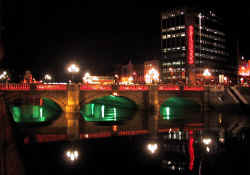 need another excuse to go back.
need another excuse to go back.
The highlight of the six Punt tour, however, is the pint you get at the
end. After conducting an exhaustive search of Ireland, I can assuredly say that the
Hopstore has the tastiest pint. Luckily I have spared you readers the trouble
of searching for yourselves... unless of course you need to confirm my
research independently. The best pint is at the veritable source, though
wise Irishman might argue that the best tasting pint is the one in your hand.
Pub culture defines Ireland. When people finish work they head for the
pub. When people go to lunch, they head for the pub. Some pubs exist
with special licenses to open in the wee hours of the morning. This is in the interest
of
fishermen of course, so they can have a drink before heading out to sea.
Why should they be denied the right to a pre-work pint? "Guinness for
bait," might be the next campaign.
Now you may begin to understand how Ireland can quaff so much
Guinness.
Dublin has many pubs. James Joyce once postulated
that it would be impossible to cross the city without passing a pub. A
radio station recently offered a prize to the first solution. The
winner? Choose any 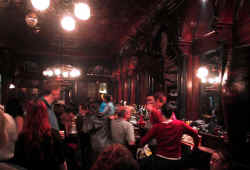 route you like just don't pass any pubs, go into them
instead. If I had known better, I would have packed an extra liver.
route you like just don't pass any pubs, go into them
instead. If I had known better, I would have packed an extra liver.
A trip to the pub is not simply about drinking. It is very much a social
activity. The pub is the hub of the community.
Often you can find live music, either traditional or
modern. Occasionally you can hear spontaneous impromptu music from patrons who
spontaneously launch into song-- sometimes even in Irish. [Their
indigenous language is called Irish by the Irish, not
Gaelic, though it is arguably dialect related to Scottish Gaelic. To
hear people speaking Irish in everyday conversation you must get to the west
coast and then get far from the cities, though many people around Ireland do
know at least some basic words, which never ever sound like they are
spelled.] And everyone has some
musical talent. Each music store I passed was busy with teenagers (boys
mostly) playing
electric guitars.
The Irish have a strong oral tradition of storytelling accompanied by a
generous helping of myths. The Irish language has many
specific words (forgive the following cliche) similar to the Eskimos many
words for snow. The precision required by their language contributes to their
heightened sensitivity of the meanings of words. Often suffering is
relieved through art, and Ireland has suffered. The language sensitivity
combined with this heritage of pain begins to explain why disproportionately so
much literature and music has come from Ireland.
How did I discover this? Let's just say I spent some time in pubs. In six
days I had a pint at more than sixteen pubs. The second best pint came
from Mulligan's. The foamy head spilled over the lip of the glass and down
to the coaster. When I lifted the pint, the coaster came with it.
The foam on the cardboard was thick enough to lift the coaster ten minutes
later. The best food was at Frazer's, north of the Liffey. The best ambience was at The Stag's Head, with honorable mention
for both food and craic, pronounced, "crack." What is "craic?" "Craic"
is Irish for a fun time. "How was the craic?" would mean,
"Was it happening?" The best craic in Dublin for me was at Grogan's Castle
Lounge.
Grogan's was intersting even without the people. In the olden days, men and women
did not drink together. Instead the women sat in a "snug," a wooden booth with a
sliding window to pass the drinks. Grogan's
does not have a traditional snug, but it is divided into two halves for probably
the same purpose. A partition with a door extends across the room from
the middle of the bar to the middle of the opposite wall. One side is carpeted, the other is not. The bar itself is L
shaped, enabling one to see from one section into the other. The big spenders
sit in the carpeted area and pay five pence more for their pints. I
happened by one afternoon for a drop. I could not leave for a several hours.
Paddy (yes that is his real name) threw back pint after pint on his lunch
break. Then an old Jewish man whistled and sang, following this with a
flourish of trumpeted fanfare through his hand. Grogan's has great craic.
In case I hadn't seen enough pubs, I headed for The Duke one night to
experience "The Literary Pub Crawl." Dublin obviously cannot
have as many pub crawls as
there are pubs, but it has many from which to choose. This one has a great reputation. Two actors
guide fifty or so people around town, pointing out the sights and stopping
into certain bars to refuel along the way. Occasionally they stop to give literary
history and to perform short scenes from Irish literature. The guides also pose
questions to be answered at the end of the tour for prizes. I managed to
qualify for a prize by shouting out an answer, but unfortunately it was one of
the last qualifying questions. The guides asked each contestant a second
question in order of their qualification for which a correct answer won a
prize. The prizes were claimed before my turn.
I had been rushing around Europe for the last two months. Traveling
with Kate I had reached a pace that would have been impossible to maintain.
In Ireland I began to slow down. I no longer felt the need to see every site in the
guidebook. I did, however,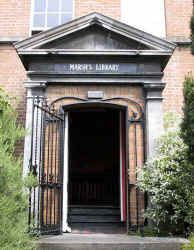 need to see Marsh's Library. An Archbishop
named Marsh had left his book collection to a library, which carries his name to
this day. I dutifully informed the staff that my name is Marsh and that I come from
the American Marsh's. I was not the first of the family to visit. The guest book
had at least two in the previous month. Archbishop Marsh came from
England and never had children, meaning I could not be a direct descendant,
though Marsh is a small family so we are likely related. Unfortunately the
library prohibits photos, so I could not photograph the portrait of the
Archbishop himself. I pleaded with the people in charge to no avail,
though the staff did commiserate and were otherwise helpful.
need to see Marsh's Library. An Archbishop
named Marsh had left his book collection to a library, which carries his name to
this day. I dutifully informed the staff that my name is Marsh and that I come from
the American Marsh's. I was not the first of the family to visit. The guest book
had at least two in the previous month. Archbishop Marsh came from
England and never had children, meaning I could not be a direct descendant,
though Marsh is a small family so we are likely related. Unfortunately the
library prohibits photos, so I could not photograph the portrait of the
Archbishop himself. I pleaded with the people in charge to no avail,
though the staff did commiserate and were otherwise helpful.
Marsh's library contains a good collection of rare books. Many years ago the librarians built
cages to insure against theft by unsupervised "scholars." A reader would be locked in
a cage with his books until he finished. I imagine that Dublin's
fire marshal would condemn that practice
today.
I decided to sit and write for a bit, it being my library after all. I
flipped open my laptop; I plugged my adapters into the wall, and I began to type. A thought
crept into my mind, perhaps spun by the spirit of the Archbishop himself. If I surreptitiously
used my digital camera without the flash while avoiding the security cameras, I
could take a
photo of the cages and even of a copy of the portrait of the Archbishop. I did
this. Shortly thereafter, the pleasant man to whom I had spoken first when
I first arrived appeared from around
the corner. He approached me and explained, "I am sorry, but I am going to
have to ask you to leave." I said that I understood but still needed a minute to pack up my things. "When
you are finished packing please find me at the front door. I should like
to talk to you on the way out." Busted!
Sheepishly I put my computer and cords away and headed towards the exit where
he awaited. He spoke first, "You see, it is lunch time and the library is closing. I
understand that you feel a connection to this place, so you are welcome to
return later
in the afternoon if you like." He hadn't seen my secret agent camera
work after all!
He continued that he also had wanted to show me the second portrait of the Archbishop by the
exit stairs. It technically is not supposed to be photographed, but he
made an
exception.
With my legitimate full-color photo of Archbishop Marsh, I grabbed a sandwich and
headed for St. Stephen's Green. The sky was clear. It was a perfect
day for a picnic. I found a nice patch of grass, ate my lunch, and lay
back with my eyes closed. Luck stayed by my side for after twenty minutes, an
Irish band began playing traditional Irish music from the bandstand. The
free concerts were to last all week. After an hour of music
I continued on with my day.
A tour of Trinity College proved much less interesting and much less
interesting than the Literary Pub
Crawl. It ended at the Book of Kells, an ancient manuscript. The
book was nicked from a monastery, though just as well because the monastery burned soon
after. A farmer found it safely buried in a field many years later. The
thieves must have buried it and forgotten where or else could not find a buyer.
The book has been painstakingly restored and displayed in an exhibit at the
College. Unless you really find old books interesting, you will likely
agree that the exhibition is overrated.
Later I visited the Dublin Writers' Museum and after that a former residence
of James Joyce, which had was a
short film on his life and a small exhibit. Most interesting were the
old photos of parts of Dublin with explanations of their appearances in Ulysses.
The house itself is an excellent example of restored Georgian architecture. The
doors of all the houses in the neighborhood were all painted a solid color with
white trim and elaborate hansoms. Transoms? Handsome hansoms?
Whatever.
On my last night in Dublin I ate my dinner at The Stag's Head. There I
met Patricia Sharkey. She was there for some craic with some friends and
coworkers. Before they arrived, we fell to chatting. This often happens
in Ireland.
You practically cannot sit down in a pub without striking up some conversation with your
neighbor. Sharkey gave me a beginning lesson on the Irish language and
also told me a bit about my family history. My mother's family name traces
back
to county Donegal as does her family name. She gave me her number and instructed me to look
her up when arrived. By now my one pint had turned into four.
Once someone buys you a pint, you are obliged to return the favor. There
is no escape from this pub dance; it can continue ad nauseum. My
friend Aidan once understated this phenomenon when he explained of this vicious
cycle that, "It can be a bit of a
problem at times." There, a bona fide Irishman said it. I bid
everyone a good night and went home to bed.
Dingle
In the morning I caught a long bus to Dingle on the west coast of Ireland. Several
people had recommended the Dingle peninsula as prettier than the Ring of Kerry
while slightly less touristed. These tips helped convince me to skip the south coast, or
more properly to save it for another trip. After a scenic ride across
Ireland (Limerick excepted), I disembarked in Dingle and jumped into the hostel van for the Ballintaggart Guest House. Paul was driving, an
Aussie "gone walkabout," but working at the hostel for more travel
money. Paul refers to everyone as
"Buddy," and had already picked up the Brit phrase, "Sound as a
pound." He then gave it an Aussie twist, adding the word "mate" at the
end. "Aw buddy, that's sound mate--sound as a pound. That's
sound as
ten pounds, buddy!" Paul is a gas. He can talk to anyone about
anything for any length of time. (As of this writing he was supposed to be
back home for a wedding. Last that I heard he was still in Europe, five months
late.)
Paul offered to show me a good cheap place to eat in town, so we caught the evening
van and popped in to Maire de Barre's for some grub. I learned about baby
Guinness from a friend of his--a shot of Bailey's floated on top of Kalhua, or
alternatively use a bigger glass with a bit of Guinness, add a splash of Kalhua and
float the Bailey's on top. Luckily Paul had to meet some people for dinner, so I
was spared a heavy pub crawl that night, though he did brief me on where to find the
best bars in town.
Dingle is a fishing village that has significant tourist income
during the summer, though somehow without ruining the small-town feel. Brightly colored
houses make up the town center. Towns in Ireland are rated on
the quality of the pubs, and Dingle rates highly. My personal favorites were
"Dick Mack's" and "Foxy John's." Both have secondary
income when they aren't serving pints. Dick Mack's is a leather goods shop--you can buy shoes or have
your belt repaired here. Foxy John's is a sometime hardware store. Look up from your beer
you see hammers and garden hose
hanging from the ceiling. Truthfully, I never saw a sale made from these
second businesses, so perhaps it is just for show, though the amount of dust
implied that the stock does rotate.
The Ballintaggart Guest House is an old manor home that has been turned i nto
a hostel. At least a mile out of town, it is a hostel with a lot of
character. The building is made from stacked rock and plastered over with
a courtyard in the middle. Fields surround the place, which looks out to
the ocean. The photo on the right is the view out of the window of my
first room. The staff was super friendly too,
making for a great stay. More than one traveler has ventured in to the
Ballintaggart and stayed for months. I met my friend Rana here, and this nearly
happened to her, though she escaped at the last minute. A religious German youth group
was here on retreat through most of my stay. Occasionally we would hear
them singing songs
after dinner. It was also at the Ballintaggart that I met Caitlin and Laura from Boston whom I would run
into again later.
nto
a hostel. At least a mile out of town, it is a hostel with a lot of
character. The building is made from stacked rock and plastered over with
a courtyard in the middle. Fields surround the place, which looks out to
the ocean. The photo on the right is the view out of the window of my
first room. The staff was super friendly too,
making for a great stay. More than one traveler has ventured in to the
Ballintaggart and stayed for months. I met my friend Rana here, and this nearly
happened to her, though she escaped at the last minute. A religious German youth group
was here on retreat through most of my stay. Occasionally we would hear
them singing songs
after dinner. It was also at the Ballintaggart that I met Caitlin and Laura from Boston whom I would run
into again later.
My first morning I decided to chance the threatening rain and walk along the
"cliffs" into town. One of the local attractions is Fungie the
dolphin. He can be seen frolicking around the tour boats that leave from
town. I had been told that one could see him for free from the shore, and that it
was a nice walk, so I grabbed my slicker and set out. The green fields in
the above photo roll up to the ocean where they drop twenty feet to the
water. Picking my way through cow pasture, I came across an old stone
watchtower. Soon after I spotted Fungie (warning: do not eat spotted
fungie for it can be poisonous), though were it not for the two
boats chasing him I never would have noticed him. By the time I got town it
was raining.
I stopped into the grocery store where I ran into Mike and Amber, two Aussies
who were also staying at the hostel. We decided to join forces to cook a
gourmet dish of chicken cordon bleu. We decided this after first stopping
at the Small Bridge
Bar to watch some of the "Gaelic Games." The two major Gaelic
sports are
Gaelic Football and Hurling. I had arrived in Dublin just after a hurling match
the week before, meaning this was the week for football. Gaelic football is more like
Rugby
than Football (American) but even more like Australian Rules Football than
Rugby.
Since the Claire team (Dingle is in County Claire) was no longer in contention and Dublin
had an off week (everyone roots against Dublin), the crowd was not very lively. After
the match we went back to the hostel and prepared a sumptuous feast.
I had been thinking of attempting to learn to draw on this trip. If any
of you have seen my writing or one of my rare attempts to draw something
other than a map, you might understand how hopeless this is. The previous
night, an American guy had been showing his drawings at the hostel. His
drawings were very good. The next afternoon I met Rana from Melbourne who
was trying to escape the cold damp by the fire. I confessed how I would
like to be able to draw
but have no concept how to begin. She gave me my first art lesson. My
initial attempts have been more surrealist than not, but I do seem
to be improving SLOWLY. Later Rana, Thea, a like, total surfer
girl from San Diego, and I met up for drinks at Dick's and Foxy's. Rana
knew the back road, so rather than wait for the van we walked under spellbindingly clear starry skies
(The stars are so, like, bright. I can, like, feel the Karma of the universe, you
know?).
Slea Head is the very tip of the Dingle Peninsula. It is a less-than-pleasant bike ride in poor weather. The next morning
was overcast, so I opted for an
inexpensive taxi-tour of the local sites along with five other tourists. Our
first
stop was the roofless ruins of an old church. Behind the altar, or rather
where it would
have been, was a narrow window called the "eye of the needle" due to its shape.
People who can fit through the eye supposedly get into heaven. Apparently even God is body conscious. (Yes I
fit, btw. Going up baby!)
The next stop was an even older church, one built entirely from stone. The
structure looks as if it was built a millennium ago, and I believe it was.
Built without mortar, the flat stones pile on top of 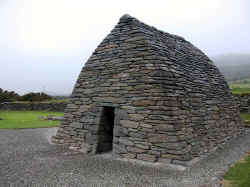 each other until the walls meet. There is
one small door which probably had an animal skin to keep out the cold, and one
small narrow window at the back (much too small to squeeze through, not that I
tried).
each other until the walls meet. There is
one small door which probably had an animal skin to keep out the cold, and one
small narrow window at the back (much too small to squeeze through, not that I
tried).
Finally at the very tip of the peninsula we could barely see the barren Blasket
Islands below the impending clouds. This will be the closest I get to Maine for
another year. Climbing back into the warmth of the
van we drove back past innumerable sheep (welcome to Ireland!) with colored paint on their wool.
Rather than tag or brand the sheep, the each farmer marks his sheep with a paint
splotch of a primary color. Since there are only so many primary colors
and many, many sheep, the farmers paint different parts. One will paint
the head and
another the rump. In this way the sheep can mingle together and still be
easily sorted later. The paint disappears out when the shorn wool is washed and bleached
later.
When I got back to the hostel I found people celebrating Grubbs'
birthday. Grubbs is dating Paul. Grubbs is not her real name, but
everyone calls her Grubbs. No one seemed quite sure where the name came
from
but theorized that it probably has something to do with the fact that she works
for Stubbs. Stubbs, also not his real name, was there with his guitar and long-hair-rock-star-look. He entertained us all with music into the wee hours.
I had heard that the Ballintaggart manor/guesthouse is haunted. It was at
Grubbs' birthday party that I learned the story. The lord of the manor discovered his wife with another. Legend
explains that he strangled her in the room now known as Room
E. That very morning I had moved from Room D into Room E. Occasionally the lady's ghost becomes playful
and tickles the feet of sleeping hostellers, though only the feet of men. At
bedtime I went up to Room E--and discovered that my sleep-sheet was no longer
where I had placed it on my bunk.
After looking all over I finally found it on the other side of the room under
another bed. Assuming it was the work of the wind, I went to sleep.
During the night I dreamed about dancing 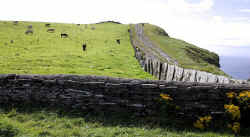 with the ghost. I
had been talking about it all evening, but it was a little odd to meet her as I
slept.
with the ghost. I
had been talking about it all evening, but it was a little odd to meet her as I
slept.
In the morning I caught the bus back to Tralee and another north to Doolin. See
the cows in the photo on the left? See the edge of the field? Now
look at the photo on the right. Welcome to the awesome Cliffs of Moher.  One wrong step by a cow and kersplatt. The Cliffs are Ireland's most
striking sight, dropping from those green pastures 200 meters to the blue ocean
below. I had planned to make a daytrip from Doolin eight kilometers away,
but luckily (or was it?) the bus stopped for an hour en route. An hour was plenty of time to
walk around and snap some photos, after which I got back on the bus and continued on
to Doolin.
One wrong step by a cow and kersplatt. The Cliffs are Ireland's most
striking sight, dropping from those green pastures 200 meters to the blue ocean
below. I had planned to make a daytrip from Doolin eight kilometers away,
but luckily (or was it?) the bus stopped for an hour en route. An hour was plenty of time to
walk around and snap some photos, after which I got back on the bus and continued on
to Doolin.
Doolin
Doolin is a small town that draws both Irish and backpackers throughout the
summer. It has as many pubs as hostels--three of each. Its pubs are
known for good traditional music. Doolin is definitely a musical
town.
 I
had made a reservation at the Aille River hostel. It is a small house
nestled in the valley that (surprise) contains the Aille river. The hostel is
smaller than most, yet it has a kitchen, laundry, internet access, and a scenic
view. While I was doing my laundry, Laura and Caitlin arrived.
I
had made a reservation at the Aille River hostel. It is a small house
nestled in the valley that (surprise) contains the Aille river. The hostel is
smaller than most, yet it has a kitchen, laundry, internet access, and a scenic
view. While I was doing my laundry, Laura and Caitlin arrived.
We three headed out to listen to some music at one of the pubs, though we
ended up talking to each other instead of listening. The two of them introduced me to a
bastardization of Guinness--adding black currant syrup to make it
sweeter. Still, at least they were drinking the black stuff, which after
all gives you strength. Finally
it was time to hit the hay.
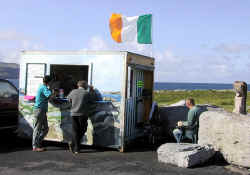 The next morning the two of them
left to catch a ferry. We said goodbye knowing that we would meet up in Galway. I walked down to the
ferry docks after them, though they had departed by the time I arrived.
Nonplussed, I grabbed a scone and a coffee for breakfast from the local coffee
shop and ate on the rocks, much like the man on the right in the photo to the
right.
The next morning the two of them
left to catch a ferry. We said goodbye knowing that we would meet up in Galway. I walked down to the
ferry docks after them, though they had departed by the time I arrived.
Nonplussed, I grabbed a scone and a coffee for breakfast from the local coffee
shop and ate on the rocks, much like the man on the right in the photo to the
right.
Since my bus didn't leave until 2 pm, I decided to walk along the coast for a
while. I climbed over styles into cow pastures, read a sign warning
against feeding the local dolphins, and saw an interesting grotto carved by the ocean.
The ocean slowly dropped away as I approached the Cliffs of
Moher. The vertical rock walls began to force the wind from the ocean upward.
Hundreds of seagulls were frolicking on the gusts. I sat and 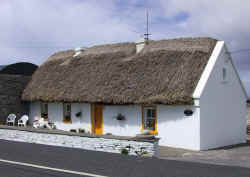 watched them
for about twenty minutes before heading onward. Finally I was nearly back
to the point where
I had been the day before. The cliffs were much more impressive having
hiked their length. The Cliffs of Moher have a verdant green mesmerizing
beauty.
watched them
for about twenty minutes before heading onward. Finally I was nearly back
to the point where
I had been the day before. The cliffs were much more impressive having
hiked their length. The Cliffs of Moher have a verdant green mesmerizing
beauty.
Not sure of the time (having made the statement "I will not let time
control me," by leaving my watch in Maine), I made my way back to the main road
to town. I had heard that hitchhiking in Ireland is somewhat common,
though in the States common wisdom implies that hitching is tantamount to
suicide. I was afraid of missing the bus, but I was not yet ready to stick
out my thumb, so I hoofed it the whole way. My reward was to see some traditional houses, including one that was
being re-roofed. Every couple of years the thatch has to be
replaced. The task requires several people, part of the reason why most
traditional houses have more modern roofs now. 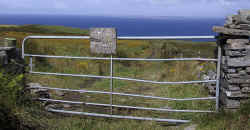
As I walked along the road I noticed this sign at the entrance to
one of the fields I have traversed in my hike. It warns of the
danger in entering the area (click it to read the much more elegant phrasing). All I know is this sign contained
more bullshit than the field behind it did.
Arriving back in town just before 2 p.m., I had just enough time to grab my
pack and get to the stop before the bus showed up. We drove north towards
Galway through the Burren. One of Cromwell's men despaired that the land
was hopelessly desolate. "There are no trees high enough to hang a
man, nor no water deep enough to drown him." The ride through
confirmed this. The hills are bald. Loose stones litter the
landscape. Even the stone walls seemed not to have decreased the rocks
that litter the landscape.
Next: Galway
 good
pint. In college I had talked about making a pilgrimage to St. James'
Gate, but it was too late in the day to attempt. Instead I walked into
the more touristy Temple Bar area, nursed a blonde in a black skirt (that would be a
pint), and listened to some traditional Irish music.
good
pint. In college I had talked about making a pilgrimage to St. James'
Gate, but it was too late in the day to attempt. Instead I walked into
the more touristy Temple Bar area, nursed a blonde in a black skirt (that would be a
pint), and listened to some traditional Irish music. 











